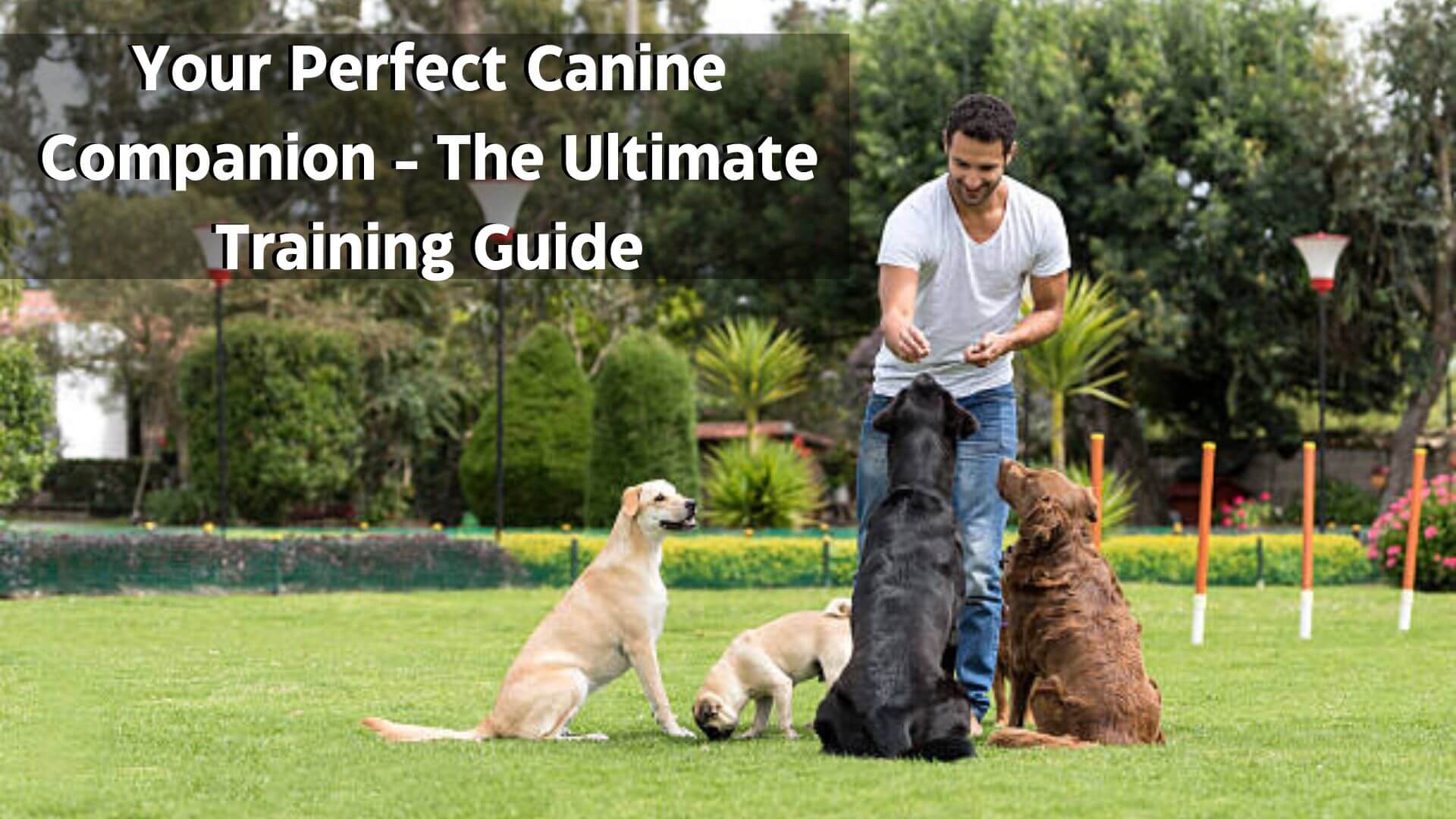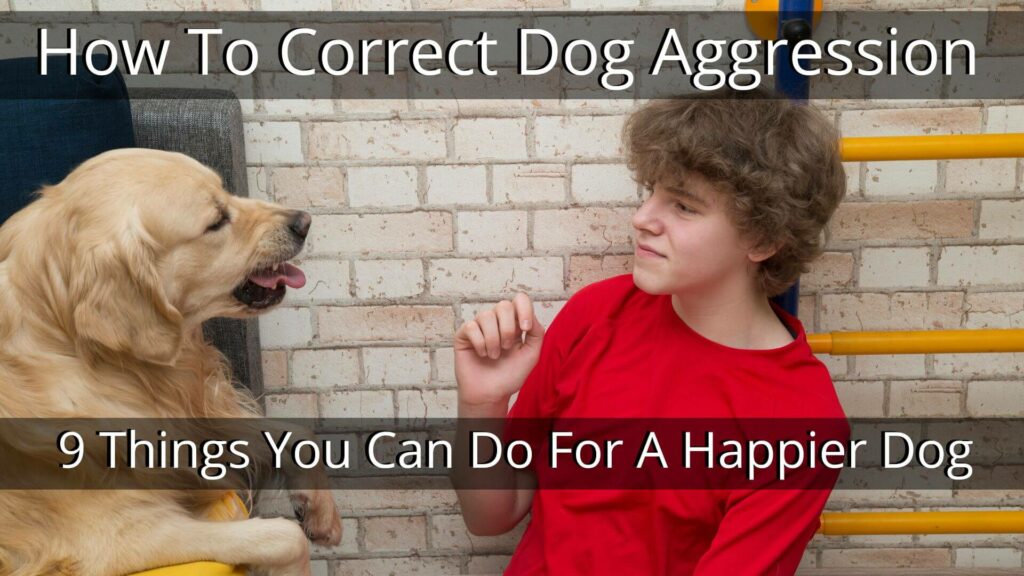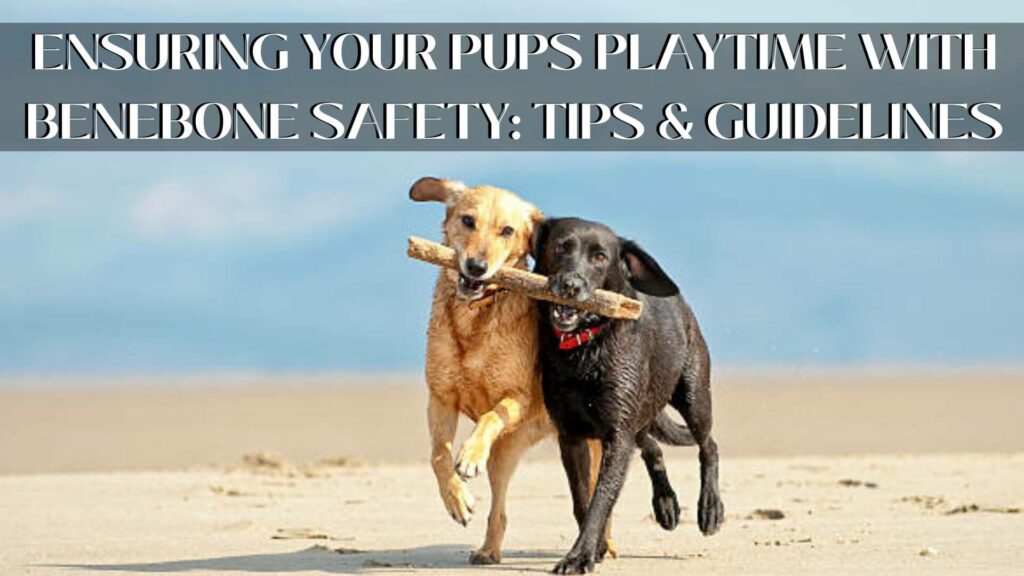If you’re looking for the perfect canine companion, you’re in the right place! Owning a well-trained and well-behaved dog can make all the difference in your daily life. Not only is it more enjoyable to have a dog who listens and behaves, but it can also lead to a stronger bond between you and your furry friend. In this ultimate training guide, we’ll cover everything you need to know to train your dog and create the perfect canine companion. From basic obedience to advanced tricks and addressing behavioral issues, we’ve got you covered. So, grab your furry friend, and let’s get started!
Training your dog is important for several reasons:
- Safety – A well-trained dog is less likely to engage in dangerous behaviors such as biting or running into the street, which can lead to accidents and injuries.
- Socialization – Training can help your dog learn to be comfortable around other dogs and people, reducing the risk of aggressive or fearful behavior.
- Bonding – Training can help strengthen the bond between you and your dog, improving communication and trust.
- Convenience – A well-behaved dog is easier to live with and can make everyday activities such as walks, visits to the vet, and travel more enjoyable.
- Mental Stimulation – Training can provide mental stimulation and help prevent boredom, which can lead to destructive behavior.
Training your dog can improve its quality of life and strengthen your relationship with your furry companion.
Here’s an overview of what our ultimate training guide will cover:
- Understanding Your Dog’s Behavior – This section will cover the basics of canine behavior and how it relates to training, the importance of positive reinforcement, and tips for reading your dog’s body language.
- Basic Training Techniques – We’ll cover essential commands such as sit, stay, come, and heel, along with tips for using positive reinforcement to train your dog.
- Advanced Training Techniques – In this section, we’ll cover more advanced commands and tricks, such as roll over and play dead, along with using clicker training to teach your dog.
- Addressing Behavioral Issues – We’ll discuss common behavioral problems such as barking, chewing, and jumping, along with tips for modifying behavior through training.
- Exercise and Enrichment – This section will cover the importance of exercise and mental stimulation for dogs, along with examples of games and activities to keep your dog engaged and entertained.
- Special Considerations – We’ll discuss training considerations for puppies, senior dogs, and dogs with special needs, along with tips for socializing your dog with other dogs and people.
By the end of this guide, you’ll have all the tools you need to train your dog and create the perfect canine companion.
Understanding Your Dog’s Behavior
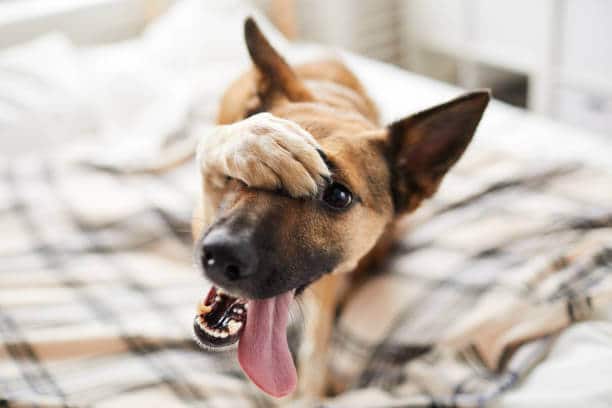
If you’re aiming to have a perfect canine companion, it’s essential to understand your dog’s behavior. A well-behaved dog is often the result of proper training and a good understanding of canine behavior. This section will cover the basics of canine behavior and how it relates to training. We’ll discuss the importance of positive reinforcement and the drawbacks of punishment-based training. Additionally, we’ll provide tips for reading your dog’s body language, which can help you understand their behavior and improve your communication with them. So, let’s dive into understanding your dog’s behavior and take the first step toward creating the perfect canine companion.
Basics Of Canine Behaviour Relating To Training

Canine behavior is rooted in their natural instincts, which are based on their evolutionary history as pack animals. Understanding these instincts can help you train your dog effectively.
One of the most important instincts is the pack mentality. Dogs are social animals and have a natural tendency to form hierarchies within a group. As a pet owner, it’s important to establish yourself as the pack leader and to train your dog to respect your authority.
Another instinct is the drive to please their owners. Dogs are loyal and want to please their owners, which makes positive reinforcement an effective training tool. Using rewards such as treats, praise, and playtime can help reinforce good behavior and create a positive association with training.
It’s also essential to recognize that each dog has a unique personality, and not all training techniques will work for every dog. Some dogs respond well to praise, while others may need more structure and discipline. This is why reading your dog’s body language and adjusting your training approach is important.
Understanding canine behavior is crucial for effective dog training. Understanding their natural instincts allows you to train your dog to behave well and be a perfect canine companion. Additionally, recognizing your dog’s individual personality and tailoring your training approach accordingly will ensure the best results.
Positive Reinforcement Training V Punishment Based Training

Positive reinforcement is a training method that rewards desirable behavior, such as sitting or staying, with treats, praise, or playtime. This technique is based on the principle that dogs will repeat behaviors that lead to positive outcomes. Positive reinforcement is an effective and humane training method that encourages good behavior, builds a bond between owner and dog, and is proven to be more effective than punishment-based methods.
On the other hand, punishment-based training involves using negative consequences, such as yelling or physical discipline, to discourage undesirable behavior. Punishment-based training can damage the dog’s mental and emotional well-being and lead to fear, anxiety, and even aggression. It can also harm the bond between the owner and the dog, leading to more serious behavior problems.
Positive reinforcement has several advantages over punishment-based training. Firstly, it builds trust and strengthens the bond between the owner and the dog. Secondly, it encourages the dog to behave well and can prevent future behavior problems. Thirdly, it helps create a positive association with training, making it more enjoyable for both the owner and the dog.
In summary, positive reinforcement is an effective and humane training method that encourages good behavior, builds a bond between owner and dog, and is proven to be more effective than punishment-based methods. Punishment-based training, on the other hand, can be harmful and lead to more serious behavior problems. It’s essential to use positive reinforcement to train your dog and create a well-behaved and happy canine companion.
How To Read Your Dogs Body Language
Reading your dog’s body language is essential to understanding their behavior and communicating effectively with them. Here are some tips for reading your dog’s body language:
- Ears – Pay attention to the position of your dog’s ears. It could indicate they are interested or alert if they are perked up and forward. If their ears are pulled back against their head, it could mean they are scared or anxious.
- Tail – The position of the tail can tell you a lot about your dog’s mood. If their tail is high and wagging, it could mean they are happy and excited. If their tail is tucked between their legs, it could indicate fear or anxiety.
- Eyes – Your dog’s eyes can convey much information about its mood. If they are wide open and staring, it could indicate that they are interested or alert. If their eyes are half-closed, it could mean they are relaxed or content. Dilated pupils may indicate fear or excitement.
- Body posture – The position of your dog’s body can also tell you a lot about its mood. If they are standing tall with their weight evenly distributed, it could indicate that they are confident and relaxed. If they are crouched low to the ground, it could indicate fear or submission.
- Vocalizations – Pay attention to your dog’s sounds, such as barking or whining. Different vocalizations can indicate emotions or needs, such as excitement or anxiety.
- Licking, yawning, and panting – Dogs may lick their lips, yawn, or pant excessively in stressful situations. These behaviors can indicate anxiety, discomfort, or stress.
It’s important to remember that reading your dog’s body language takes practice and observation. By paying attention to these cues and observing your dog’s behavior over time, you can better understand their mood and communicate with them effectively. If you are unsure about your dog’s behavior, it’s always best to consult a professional dog trainer or veterinarian.
Basic Training Techniques

Basic training is essential if you’re striving to have a perfect canine companion. Basic obedience training is the foundation of a well-behaved dog and can prevent common behavior problems such as jumping, barking, and pulling on the leash. In this section, we’ll cover the essential commands, such as sit, stay, come, and heel, along with tips for using positive reinforcement to train your dog. By the end of this section, you’ll have the tools you need to train your dog and start them on the path to becoming the perfect canine companion.
The Basics – Sit, Stay, Come & Heel
Basic commands such as sit, stay, come, and heel are crucial for creating the perfect canine companion. These commands form the foundation of obedience training and are essential for preventing common behavior problems. Here are some tips for training your dog on these basic commands:
- Sit – The sit command is essential to help prevent jumping and encourage good behavior. To teach your dog to sit, hold a treat above its head and move it back towards its tail. As your dog follows the treat, their bottom should naturally lower to the ground. As soon as they sit, give them the treat, and praise them.
- Stay – The stay command is essential for keeping your dog safe and under control. To teach your dog to stay, have them sit and then put your hand in front of them, palm out, and say “stay.” Gradually increase the distance between you and your dog while still giving them the “stay” command. Reward your dog for staying in place.
- Come – The come command is essential for recall and can help keep your dog safe in emergency situations. To teach your dog to come, start by saying their name followed by the “come” command in an upbeat tone. When your dog comes to you, reward them with a treat and praise them.
- Heel – The heel command is essential for leash training and preventing pulling on the leash. To teach your dog to heel, start by walking with them on a loose leash at your side. Use the command “heel” and reward them with treats and praise for walking beside you.
Remember to use positive reinforcement and be patient when training your dog on these basic commands. Your dog can become a well-behaved and perfect canine companion with practice and consistency.
Positive Reinforcement For Training
Positive reinforcement is essential for training your dog and creating the perfect canine companion. This technique involves rewarding desirable behavior with treats, praise, or playtime, which encourages your dog to repeat that behavior. Here are some tips for using positive reinforcement to train your dog:
- Start with simple commands – Begin by teaching your dog basic commands such as sit, stay, come, and heel. These commands are easy to teach and provide a foundation for more advanced training.
- Use rewards effectively – When your dog performs the desired behavior, reward them immediately with a treat or praise. Timing is critical, as your dog needs to understand which behavior is being rewarded.
- Be consistent – Consistency is key to successful training. Use the same command every time you ask your dog to perform a behavior and be consistent with rewards.
- Avoid punishment – Positive reinforcement rewards desirable behavior and ignores undesirable behavior. Avoid punishing your dog, as it can harm the bond between you and your dog and lead to more serious behavior problems.
- Be patient – Training takes time, and some dogs learn faster than others. Be patient and persistent, and celebrate even small successes.
Using positive reinforcement to train your dog can lead to a well-behaved and perfect canine companion. By being consistent, patient, and avoiding punishment, you can train your dog effectively and create a strong bond between you and your furry friend.
Common Mistakes & How To Avoid Them
Training a dog can be challenging, and owners make some common mistakes. Here are some examples of common mistakes and how to avoid them:
- Inconsistency – Consistency is essential in dog training. Using different commands or techniques can confuse your dog and hinder their progress. Ensure everyone interacting with your dog uses the same commands and training techniques.
- Overuse of treats – Treats can be a powerful tool for positive reinforcement, but overuse can lead to your dog becoming too reliant on them. Use treats sparingly and gradually phase them out as your dog becomes more proficient in their training.
- Punishing your dog – Punishing your dog for undesirable behavior can lead to fear, anxiety, and aggression. Instead, focus on rewarding desirable behavior and ignoring or redirecting undesirable behavior.
- Lack of patience – Training a dog takes time and patience. Rushing the process or becoming frustrated can harm the bond between you and your dog and make training more challenging. Be patient and celebrate small successes along the way.
- Neglecting exercise and mental stimulation – Training is not the only aspect of creating a perfect canine companion. Neglecting exercise and mental stimulation can lead to boredom, destructive behavior, and a lack of progress in training. Ensure your dog gets enough exercise and mental stimulation to keep them engaged and happy.
Avoiding these common mistakes can improve your dog’s training experience and create a well-behaved and perfect canine companion.
Advanced Training Techniques
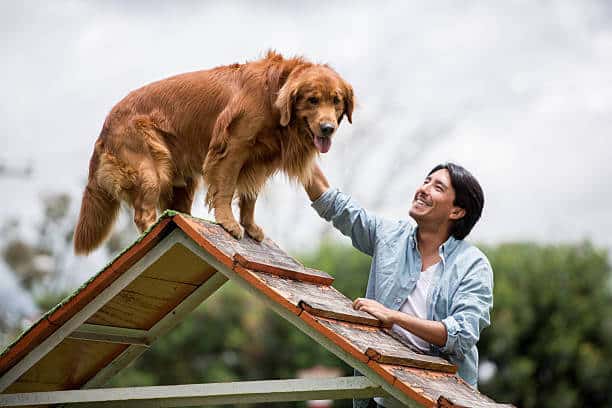
Once your dog has mastered basic obedience commands, it’s time to move on to more advanced training techniques. Advanced training can be a fun and rewarding experience for you and your furry friend and can help strengthen your bond. In this section, we’ll cover more advanced commands and tricks, such as rollover and play dead, along with using clicker training to teach your dog. By the end of this section, you’ll have the tools you need to take your dog’s training to the next level and create the perfect canine companion.
Stepping It Up A Level – Roll Over, Play Dead & Speak!
Advanced commands such as roll over, play dead, and speak can be fun and rewarding for you and your dog and can help strengthen your bond. Here are some tips for training your dog on these advanced commands:
- Roll over – To teach your dog to roll over, start by asking them to lie down. Hold a treat close to their nose and then move it towards their shoulder, encouraging them to roll onto their side. As they roll onto their side, use the command “roll over” and reward them with a treat. Over time, your dog should learn to roll over completely.
- Play dead – To teach your dog to play dead, have them lie down. Hold a treat close to their nose, then move it towards the ground, encouraging them to lie flat. Use the command “play dead” and reward them with a treat. With practice, your dog will learn to play dead on command.
- Speak – To teach your dog to speak, start by getting them excited, such as playing with a toy or running around. As your dog barks or makes noise, use the command “speak” and reward them with a treat. With practice, your dog will learn to bark on command.
Remember to use positive reinforcement and be patient when training your dog on these advanced commands. With practice and consistency, your dog can become a well-trained and perfect canine companion.
Teaching Tricks With Positive Reinforcement
Teaching your dog tricks can be a fun and rewarding experience for you and your furry friend. Here are some tips for teaching your dog tricks using positive reinforcement:
- Start with basic obedience training – Before teaching your dog tricks, ensure they have a solid foundation in basic obedience training. This will make it easier for them to understand and follow your commands.
- Use a clicker – A clicker is a small device that makes a distinct clicking sound when pressed. Clicker training can effectively teach your dog tricks, as it allows for precise timing and clear communication.
- Break the trick down into small steps – Break the trick down into small, achievable steps. This will make it easier for your dog to understand what you are asking them to do and will allow you to reward them for each step of the process.
- Use positive reinforcement – Reward your dog with treats, praise, and playtime for each step of the trick they successfully perform. This positive reinforcement will encourage them to continue to work towards completing the trick.
- Be patient – Teaching your dog tricks can take time and patience. Be patient and consistent in your training, and celebrate small successes along the way.
Some examples of tricks you can teach your dog using positive reinforcement include shaking hands, rolling over, playing dead, and jumping through hoops. By using positive reinforcement and breaking the trick down into achievable steps, you can successfully teach your dog tricks and strengthen your bond with them.
How To Use A Clicker For Dog Training
Clicker training is a positive reinforcement training method that uses a small device that makes a distinct clicking sound when pressed to mark desired behavior. Here are some examples of how to use clicker training to teach your dog:
- Teaching your dog to sit – Start by holding a treat above your dog’s head and move it back towards their tail. As their bottom naturally lowers to the ground, click the clicker and immediately give them the treat. Repeat this process until your dog associates the clicker sound with the behavior of sitting. Once they do, you can begin to use the clicker alone to mark the behavior and reward them with a treat.
- Teaching your dog to come – Start by saying your dog’s name followed by the “come” command in an upbeat tone. When your dog comes to you, click the clicker and reward them with a treat. Over time, your dog will associate the sound of the clicker with the desired behavior of coming when called.
- Teaching your dog to stay – Have your dog sit and put your hand in front of them, palm out, and say “stay.” When they stay in place, click the clicker and reward them with a treat. Gradually increase the distance between you and your dog while still giving them the “stay” command, clicking the clicker when they stay in place, and rewarding them with a treat.
Using clicker training to teach your dog can be a fun and effective way to create the perfect canine companion. By using positive reinforcement and marking desired behavior with the sound of the clicker, your dog will learn quickly and enjoy the training process. Remember to be patient and consistent in your training and celebrate even small successes along the way.
Addressing Behavioral Issues

Creating a perfect canine companion requires addressing behavioral issues that may arise during your dog’s life. Behavioral issues such as anxiety, aggression, and destructive behavior can be challenging for both you and your furry friend. In this section, we’ll cover common behavioral issues and techniques for addressing them. By the end of this section, you’ll have the tools you need to address behavioral issues and create a well-behaved and perfect canine companion.
Common Behavioural Problems
Common behavioral problems such as barking, chewing, and jumping can be frustrating for owners and can prevent your dog from becoming the perfect canine companion. Here are some tips for addressing these issues:
- Barking – Excessive barking can be a sign of anxiety or boredom. To address this issue, provide your dog with plenty of exercise and mental stimulation. You can also train your dog to be quiet on command by using positive reinforcement and rewarding them when they stop barking.
- Chewing – Chewing is a natural behavior for dogs, but it can become destructive when directed towards furniture or other items. To address this issue, provide your dog with plenty of appropriate chew toys and discourage them from chewing on inappropriate items. When you catch your dog chewing on something they shouldn’t, redirect their attention to an appropriate chew toy and reward them for chewing on it.
- Jumping – Jumping can be a sign of excitement or overstimulation. To address this issue, train your dog to sit or stay when greeting people. Use positive reinforcement to reward them for staying calm and focused and ignore jumping behavior.
Remember that addressing behavioral issues takes time and patience. Consistency is key, and it’s important to provide your dog with plenty of exercise, mental stimulation, and positive reinforcement to encourage good behavior. If you are struggling with addressing behavioral issues, consult with a professional dog trainer or veterinarian for additional guidance. With practice and dedication, you can create a well-behaved and perfect canine companion.
How Using Positive Reinforcement Will Help
Positive reinforcement can be an effective way to address common behavioral problems such as barking, chewing, and jumping and create the perfect canine companion. Here’s how to address these issues using positive reinforcement:
- Barking – To address excessive barking, use positive reinforcement to reward your dog when they are quiet. When your dog starts to bark, use a command such as “quiet” or “enough” and then reward them with a treat or praise when they stop barking. Over time, your dog will learn to associate being quiet with positive reinforcement.
- Chewing – To address destructive chewing, provide your dog with plenty of appropriate chew toys and reward them when they chew on them. When you catch your dog chewing on something they shouldn’t, redirect their attention to an appropriate chew toy and reward them for chewing on it. With consistency, your dog will learn to prefer the appropriate chew toys over inappropriate items.
- Jumping – To address jumping, train your dog to sit or stay when greeting people. Use positive reinforcement to reward them for staying calm and focused and ignore jumping behavior. Over time, your dog will learn that sitting or staying is more rewarding than jumping.
Remember to be patient and consistent in your training. Positive reinforcement works by rewarding desirable behavior and ignoring undesirable behavior, rather than punishing your dog. With practice and dedication, you can address behavioral issues and create a well-behaved and perfect canine companion. If you’re struggling to address behavioral issues, consider consulting with a professional dog trainer or veterinarian for additional guidance.
Examples Of Modified Behaviour Through Training

Training can be an effective way to modify your dog’s behavior and create the perfect canine companion. Here are some examples of how to modify behavior through training:
- Separation anxiety – Separation anxiety is a common problem for dogs, and it can be addressed through training. Start by leaving your dog alone for short periods of time and gradually increasing the duration. Use positive reinforcement to reward your dog when they stay calm and quiet while you are away. Over time, your dog will learn that being alone is not a scary or stressful experience.
- Leash pulling – Leash pulling can be frustrating and uncomfortable for owners. To address this issue, start by training your dog to walk on a loose leash. Use positive reinforcement to reward your dog when they walk calmly and stop rewarding them when they pull. Over time, your dog will learn that walking on a loose leash is more rewarding than pulling.
- Aggression – Aggression can be a serious problem for dogs, and it’s important to address it as soon as possible. Consult with a professional dog trainer or veterinarian to develop a training plan that is tailored to your dog’s specific needs. This may include desensitization and counter-conditioning techniques, as well as using positive reinforcement to reward desirable behavior and ignoring or redirecting undesirable behavior.
related article – how to correct dog aggression
Dogs are the best. They’re always happy to see you, they wag their tails and give you wet kisses. But sometimes, they can be a little too enthusiastic – especially when they’re around strangers or other animals. If your dog has a tendency to act aggressively, don’t worry! There are plenty of things you can do to correct his behavior.
By using positive reinforcement and tailoring training to your dog’s specific needs, you can modify behavior and create a well-behaved and perfect canine companion. Remember to be patient and consistent in your training and consult with a professional if you are struggling with modifying your dog’s behavior.
Exercise and Enrichment
Regular exercise and mental stimulation are essential for creating a perfect canine companion. Exercise helps keep your dog physically healthy, while mental stimulation can prevent boredom and destructive behavior. In this section, we’ll cover different types of exercise and enrichment activities that you can do with your dog to keep them happy and healthy. By the end of this section, you’ll have the tools you need to provide your dog with the exercise and enrichment they need to thrive.
The Importance Of Exercise & Mental Stimulation
Exercise and mental stimulation are essential for creating a perfect canine companion. Regular exercise helps keep your dog physically healthy, while mental stimulation can prevent boredom and destructive behavior. Here are some reasons why exercise and mental stimulation are so important for dogs:
- Physical health – Regular exercise can help keep your dog at a healthy weight, improve their cardiovascular health, and strengthen their muscles and bones. Exercise can also reduce the risk of certain health problems, such as diabetes and arthritis.
- Mental health – Mental stimulation can prevent boredom and reduce the risk of destructive behavior such as chewing and digging. Mental stimulation can also provide your dog with a sense of purpose and fulfillment, leading to improved overall mental health.
- Bonding – Exercise and enrichment activities provide opportunities for bonding between you and your dog. These activities can also help build trust and improve communication between you and your furry friend.
- Behavior – Exercise and mental stimulation can help prevent behavior problems such as separation anxiety and aggression. Dogs who receive enough exercise and mental stimulation are less likely to engage in destructive behavior or act out due to stress or boredom.
By providing your dog with regular exercise and mental stimulation, you can help create a well-rounded and perfect canine companion. Remember to tailor exercise and enrichment activities to your dog’s specific needs and abilities and consult with a professional if you have any questions or concerns.
The Games Dogs Play
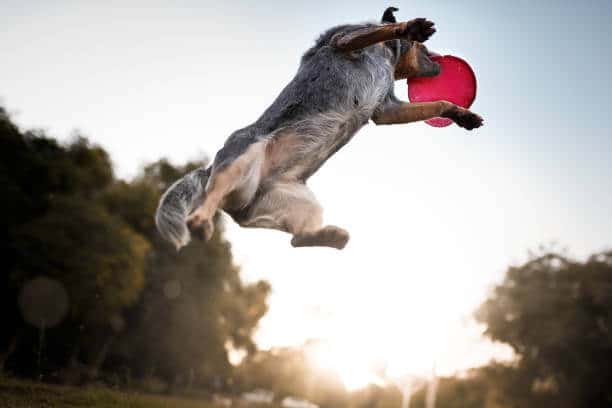
Here are some examples of games and activities that can keep your dog engaged and entertained:
- Fetch – Playing fetch is a classic game that many dogs love. To keep your dog engaged and entertained, try using different types of balls or toys, such as frisbees or squeaky toys. You can also mix up the direction and distance of your throws to keep your dog on their toes.
- Puzzle toys – Puzzle toys are a great way to provide your dog with mental stimulation. These toys often require your dog to solve a puzzle or figure out how to access a treat hidden inside. To keep your dog engaged and entertained, try rotating different types of puzzle toys and filling them with different types of treats.
- Agility courses – Agility courses are a fun and challenging way to provide your dog with physical and mental exercise. You can set up a course in your backyard or at a local park using items such as cones, hurdles, and tunnels. To keep your dog engaged and entertained, try changing up the course each time you practice and using different types of obstacles.
- Hide and seek – Playing hide and seek with your dog can be a fun way to provide mental stimulation and build a bond between you and your furry friend. To play, have your dog stay in one room while you hide in another. Then call your dog’s name and wait for them to find you. To keep your dog engaged and entertained, try hiding in different locations and using different call signals.
Remember, keeping your dog engaged and entertained is key to creating the perfect canine companion. Mix up games and activities, and tailor them to your dog’s specific needs and abilities. Always supervise your dog during playtime and make sure to provide plenty of water breaks and rest time as needed.
Bringing Playtime To Training
Incorporating training into playtime is a great way to provide mental stimulation and reinforce good behavior, ultimately leading to the perfect canine companion. Here are some ways to incorporate training into playtime:
- Use playtime as a reward – Use playtime as a reward for good behavior during training sessions. For example, after your dog successfully completes a training task, reward them with a game of fetch or a puzzle toy.
- Practice commands during playtime – Practice commands such as sit, stay, and come during playtime. For example, have your dog sit and stay before you throw a ball or call them to come back to you after they retrieve the ball.
- Incorporate training into games – Incorporate training into games such as hide and seek by having your dog sit and stay before you hide and calling them to come find you.
- Use toys as training tools – Use toys as training tools by teaching your dog to drop, leave it, or bring it to you on command. This can also help prevent destructive chewing behavior by directing your dog to appropriate chew toys.
By incorporating training into playtime, you can provide mental stimulation and reinforce good behavior, leading to a well-behaved and perfect canine companion. Remember to keep playtime fun and engaging, and to tailor training to your dog’s specific needs and abilities.
related article – your pups playtime with benebones
As a dog owner, you know that finding the perfect toy for your furry friend can be a bit of a challenge. But if you’re a fan of Benebone toys, you’re in luck! These tasty chews are a hit with dogs of all shapes and sizes, but choosing the right one for your pup’s size and chew strength is important.
Special Considerations

Creating a perfect canine companion requires taking special considerations into account. Just like humans, dogs have different needs and requirements depending on factors such as breed, age, and health conditions. In this section, we’ll cover some special considerations to keep in mind when caring for your dog, such as providing specialized diets, accommodating for disabilities, and addressing senior dog needs. By the end of this section, you’ll have the tools you need to create a happy and healthy life for your furry friend.
Training For Puppies, Senior Dogs & Dogs With Special Needs
Training considerations can vary depending on your dog’s age, health condition, and other special needs. Here are some training considerations to keep in mind for puppies, senior dogs, and dogs with special needs to create a perfect canine companion:
- Puppies – Puppies require extra patience and consistency when it comes to training. Keep training sessions short and frequent, and use positive reinforcement to encourage good behavior. Be sure to socialize your puppy early on to prevent fear or aggression towards other dogs or people.
- Senior dogs – Senior dogs may have decreased mobility or sensory capabilities, which can affect training. Modify exercises and training techniques to accommodate for any limitations or health conditions. Use positive reinforcement to encourage good behavior, but be sure to also allow for plenty of rest time and breaks.
- Dogs with special needs – Dogs with special needs, such as hearing or vision impairments, may require specialized training techniques. Use positive reinforcement to encourage good behavior, but be sure to also provide additional physical cues or communication methods as needed.
Remember, training considerations can vary depending on your dog’s individual needs and abilities. Consult with a professional dog trainer or veterinarian if you have any questions or concerns. With patience, consistency, and a tailored approach, you can create a well-behaved and perfect canine companion, no matter their age or special needs.
Pampering Your Pooch: How to Train Your Dog to Enjoy Grooming and Vet Visits

Training your dog to be comfortable with grooming and veterinary visits is an important part of creating the perfect canine companion. Here are some tips on how to train your dog to enjoy these experiences:
- Start early – Start exposing your dog to grooming and veterinary experiences early on in their life. This will help them become accustomed to the sights, sounds, and smells associated with these experiences.
- Use positive reinforcement – Use positive reinforcement to reward your dog for calm and relaxed behavior during grooming and veterinary visits. Offer treats and praise for staying calm and cooperative.
- Gradual exposure – Gradually expose your dog to grooming and veterinary experiences. Start with short, positive experiences and gradually increase the duration and intensity over time.
- Desensitization – Desensitize your dog to the different equipment and procedures associated with grooming and veterinary visits. Introduce them to the different tools and equipment gradually, using positive reinforcement to reward calm behavior.
- Consistency – Be consistent in your approach to grooming and veterinary visits. This will help your dog develop a routine and become more comfortable with these experiences over time.
Remember, training your dog to be comfortable with grooming and veterinary visits takes patience, consistency, and positive reinforcement. By using these techniques, you can create a well-adjusted and perfect canine companion who is comfortable and happy during grooming and veterinary visits. If you’re struggling with training your dog, consider consulting with a professional dog trainer or veterinarian for additional guidance.
Pawsome Social Skills: Tips for Socializing Your Dog with Dogs and People

Socializing your dog with other dogs and people is an essential part of creating the perfect canine companion. Here are some tips for socializing your dog:
- Start early – Start socializing your dog as early as possible. Puppies who are exposed to a variety of people, animals, and experiences during their critical socialization period are more likely to be well-adjusted and confident adult dogs.
- Supervision – Always supervise your dog when they are interacting with other dogs or people. This will help prevent any aggressive behavior and ensure that everyone stays safe.
- Positive reinforcement – Use positive reinforcement to reward good behavior during socialization. Offer treats and praise for calm and friendly interactions with other dogs and people.
- Gradual exposure – Gradually expose your dog to different types of people and dogs. Start with calm and well-behaved dogs, and gradually increase the intensity and duration of the interactions over time.
- Patience – Be patient with your dog during socialization. Some dogs may take longer to adjust to new situations, so take things at their pace and don’t rush them.
Remember, socializing your dog is an ongoing process. Even adult dogs who have not been socialized can learn new skills with patience and consistency. By socializing your dog with other dogs and people, you can create a well-adjusted and perfect canine companion who is comfortable and confident in any situation.
Perfect Canine Companion Conclusion
In summary, “Your Perfect Canine Companion – The Ultimate Training Guide” covers a range of topics related to creating a well-behaved and happy dog. The guide begins by discussing the importance of understanding your dog’s behavior and using positive reinforcement training techniques. It covers basic commands, such as sit, stay, come, and heel, as well as more advanced commands and tricks.
The guide also provides tips for reading your dog’s body language, avoiding common training mistakes, and addressing behavioral issues such as barking and chewing. Additionally, it emphasizes the importance of exercise and mental stimulation for dogs, providing examples of games and activities to keep dogs engaged and entertained. The guide concludes with a discussion of training considerations for puppies, senior dogs, and dogs with special needs, and tips for socializing your dog with other dogs and people.
By following the tips and techniques outlined in this guide, readers can create a perfect canine companion who is well-behaved, happy, and healthy.
Creating a perfect canine companion is an ongoing process that requires patience, consistency, and dedication. By following the tips and techniques outlined in this guide, you can lay the foundation for a happy and well-behaved dog. However, the work doesn’t end there. It’s important to continue training and bonding with your dog throughout their life. The more time and effort you invest in your dog’s training and socialization, the more you’ll get out of the relationship.
So, keep practicing those commands, trying out new games and activities, and spending quality time with your furry friend. With continued training and bonding, you can create the perfect canine companion who brings joy and companionship to your life for years to come.
Remember… Owning a dog should be FUN, not a chore!
My name is Mark and I currently live in Australia.
I am passionate about educating Doggie parents and helping you to make the best possible decisions to help your dog live a long, happy and healthy life.
As a Dog trainer & behaviorist I have always used The Dog Solution methods with a 100% success rate.
Feel free to contact us, and stay tuned for updates and informative posts on dog care, training, diet, and much more!
“Dogs do speak, but only to those who know how to listen” – Orhan Pamuk



